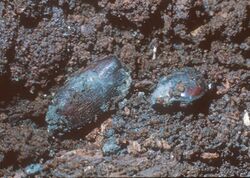Biology:Metarhizium majus
From HandWiki
Short description: Species of fungus
| Metarhizium majus | |
|---|---|

| |
| Remains of Oryctes rhinoceros adult infected with M. majus: Dipolog, Mindanao, Philippines (1977) | |
| Scientific classification | |
| Domain: | Eukaryota |
| Kingdom: | Fungi |
| Division: | Ascomycota |
| Class: | Sordariomycetes |
| Order: | Hypocreales |
| Family: | Clavicipitaceae |
| Genus: | Metarhizium |
| Species: | M. majus
|
| Binomial name | |
| Metarhizium majus (J.R.Johnst.) J.F.Bisch., Rehner & Humber (2009)
| |
| Synonyms | |
|
Metarhizium anisopliae var. majus | |
Metarhizium majus[1] is the name given to a group of fungal isolates that are known to be virulent against Scarabaeidae, a family of beetles. Previously, this species has had variety status in Metarhizium anisopliae (var. majus) and its name is derived from characteristically very large spores (typically 2.5–4 µm x 10–14 µm long) for the genus Metarhizium. There has been considerable interest in developing isolates of this species into mycoinsecticides: especially against the coconut and oil palm beetle pest Oryctes in SE Asia, the Pacific region and Africa.
-
Metarhizium majus infected Oryctes rhinoceros larva with hyphal (whitish colour) and conidia sporulation/geminating (greenish colour) from its cuticle.
-
Stages of Oryctes rhinoceros larva infected with M. majus. From left to right, 1st column: Infection symptom with "black dotes" or necrotic spots on integument; 2nd: Mummified; Mycelium (whitish colour) grow on integument; 3rd: Conidia (greenish colour) grow on integument; 4th: Decomposed grubs.
It is an anamorph, its telomorphic form is Cordyceps brittlebankisoides.[2]
Important isolates
- The epitype is isolate ARSEF 1914: derived from a dried US National Fungus Collection culture (BPI 878297)[1].
References
- ↑ Bischoff J.F., Rehner S.A. and Humber R.A. (2009). "A multilocus phylogeny of the Metarhizium anisopliae lineage". Mycologia 101 (4): 512–530. doi:10.3852/07-202. PMID 19623931. https://naldc-legacy.nal.usda.gov/naldc/download.xhtml?id=32523&content=PDF.
- ↑ Liu, Z. (2002). "Molecular evidence for teleomorph-anamorph connections in Cordyceps based on ITS-5.8S rDNA sequences". Mycological Research 106 (9): 1100–1108. doi:10.1017/S0953756202006378.
Wikidata ☰ Q3917223 entry
 |



